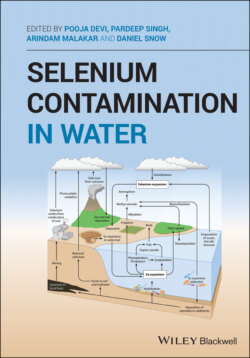Читать книгу Selenium Contamination in Water - Группа авторов - Страница 38
3.2.2 Anthropogenic Sources of Contamination in Environment
ОглавлениеSome industrial waste and processes may contribute for the addition of high levels of Se in the environment. The major source of Se contamination in air is the combustion of fossil fuels (Shah et al. 2007). The elemental Se burns to form Se dioxide in the air. The main atmospheric Se emission includes oil refining factories, mining, and milling end product manufacturing. In 1978 Harr has reported that the fossil fuel burning, emissions from industries, and municipal wastes release almost 1500, 2700, and 360 tons of Se annually, respectively (Fishbein 1983). In Canada nonferrous smelters emitted 3.02 tons of Se in 1993 as reported by Skeaff and Dubreuil. Different kind of paper also contains Se (Skeaff and Dubreuil 1997).
Incineration of papers, municipal waste, and rubber tyres are additional sources of Se in the atmosphere. Few of the sources of Se in the atmosphere have been quantified yet. Fugitive dust emissions from the fly ash settling ponds and hazardous waste sites where Se compounds were disposed of are the potential sources of Se in air (Santhanam et al. 1979). In addition to the burning of fossil fuels, smelting, mining, the disposal of industrial waste, and the processing of nuclear fuel waste also release high levels of Se into the environment. Fossil fuels and coal contain significant amounts of Se which will be added to the atmosphere during its processing in industries. The Se is present in the crude oil in the form of seleniferous marine shale which contains a fairly good amount of Se which is sent into the atmosphere through waste water generated during refining process. Levels of release of Se through different refining processes are different. The desalting process releases less Se, and atmospheric distillation causes elemental Se to be formed and partitioned with suspended matter, and processed stream water discharges high levels of Se from hydro‐treatment and catalytic cracking units. In the end step, the processed oil still contained increased levels of Se, which was examined during sour water treatment (Willig 2014).
Many electronics industrial waste also contains Se as Se is an essential component in the electronics accessories such as capacitors, printers/toners, and photocopiers etc. It is also used in semiconductors, photoelectric cells, glass, and pharmaceuticals production, the waste of which goes into the landfills and incineration and is added to environment. Leachates obtained from landfilling units of such industries wastes show increased levels of Se.
The radioactive isotope of Se, i.e. 79Se34 may also be a component of nuclear waste. The release of this isotope contributes Se content in soil, plants, and water when accidentally released from nuclear waste repositories or power plants. Smelting of ores such as nickel, zinc, and copper also releases Se in atmosphere through volatization. The Se concentration in the environment is increasing day by day and may lead to environmental pollution which is very harmful for human beings (Duce 1987).
